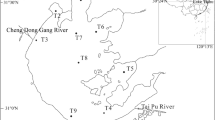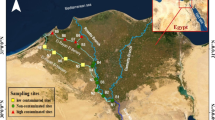Abstract
Macrobenthic assemblages are widely used as a tool for ecological assessment studies and monitoring programs. However, studies of macrobenthic assemblages have been limited in tropical coastal and marine environments in comparison with those in temperate zones. This study characterized at different resolution of taxonomic levels the responses of macrobenthic assemblages inhabiting subtidal areas in Bahrain to sewage effluents and heavy metal contamination. Macrobenthic assemblages impacted by nutrient enrichment showed lower levels of biodiversity, richness and evenness, and higher degree of disturbance. Multivariate statistical analyses revealed that faunal patterns of species were sufficiently comparable to those of genus and family taxonomic levels and showed 98% and 95% similarity, respectively. Ammonia, phosphate, and depth were the main environmental parameters responsible for explaining 41% of the community patterns in the study areas.
Similar content being viewed by others
References
Agard, J., Gobin, J., & Warwick, R. (1993). Analysis of marine macrobenthic community structure in relation to pollution, natural oil seepage and seasonal disturbance in a tropical environment (Trinidad, West Indies). Marine Ecology Progress Series, 92, 233–243.
Airoldi, L., & Beck, M. (2007). Loss, status and trends for coastal marine habitats of Europe. Oceanography and Marine Biology: An Annual Review, 45, 345–405.
Akhter, S., & Al-Jowder, O. (1997). Heavy metal concentration in sediment from the coast of Bahrain. International Journal of Environmental Health Research, 7, 85–93.
Alongi, D. M. (1990). The ecology of tropical soft-bottom benthic ecosystems. Oceanography and Marine Biology: An Annual Review, 28, 381–496.
Al-Sayed, H., & Dairi, M. (2006). Metal accumulation in the edible marine snail Turbo coronatus (Gmelin) from different locations in Bahrain. Arab Gulf Journal of Scientific Research, 24(2), 48–57.
Al-Sayed, H., Ghanem, E., & Saleh, K. (2005). Bacterial community and some physico-chemical characteristics in a subtropical mangrove environment in Bahrain. Marine Pollution Bulleti, 50, 147–155.
Al-Sayed, H., Mahasneh, A., & Al-Saad, J. (1994). Variations of trace metal concentrations in seawater and pearl oyster Pinctada radiata from Bahrain (Arabian Gulf). Marine Pollution Bulletin, 28, 370–374.
Altayaran, A., & Madany, I. (1992). Impact of a desalination plant on the physical and chemical properties of seawater, Bahrain. Water Research, 26(4), 435–441.
Bigot, L., Conand, C., Amouroux, J., Frouin, P., Bruggemann, H., & Gremare, A. (2006). Effects of industrial outfalls on tropical macrobenthic sediment communities in Reunion Island (Southwest Indian Ocean). Marine Pollution Bulletin, 52, 865–880.
Bosch, D., Dance, S., Moolenbeek, R., & Oliver, P. (1995). Seashells of Eastern Arabia. London: Motivate.
Clarke, K. (1990). Comparisons of dominance curves. Journal of Experimental Marine Biology and Ecology, 138, 143–157.
Clarke, K., & Glorley, R. (2006). PRIMER v6: User manual/tutorial. Plymouth: PRIMER-E.
Clarke, K., & Warwick, R. (2001). Change in marine communities: An approach to statistical analysis and interpretation. Plymouth: PRIMER-E.
Daur, D., Luckenbach, M., & Rodi, A. (1993). Abundance biomass comparison (ABC method); effects of an estuarine gradient, anoxic/hypoxic events and contaminated sediments. Marine Biology, 116, 507–218.
Dauvin, J., Gesteira, J., & Fraga, M. (2003). Taxonomic sufficiency: An overview of its use in the monitoring of subtidal benthic communities after oil spills. Marine Pollution Bulletin, 46, 552–555.
de Mora, S., Fowler, S. W., Cassi, R., & Tolosa, I. (2003). Assessment of organotin contamination in marine sediments and biota from the Gulf and adjacent region. Marine Pollution Bulletin, 46, 401–409.
de Mora, S., Fowler, S. W., Tolosa, I., Villeneuve, J., & Gattini, C. (2005). Chlorinated hydrocarbons in marine biota and coastal sediment from the Gulf and Gulf of Oman. Marine Pollution Bulletin, 50, 835–849.
de Mora, S., Fowler, S. W., Wyse, E., & Azemard, S. (2004). Distribution of heavy metals in marine bivalves, fish and coastal sediments in the Gulf and Gulf of Oman. Marine Pollution Bulletin, 49, 410–424.
Gray, J. (1989). Effects of environmental stress on species rich assemblages. Biological Journal of the Linnean Society, 37, 19–32.
Gray, J. S. (1997). Marine biodiversity: Patterns, threats and conservation needs. Biodiversity and Conservation, 6, 153–175.
Gray, J. S., McIntyre, A. D., & Stirn, J. (1992). Manual of methods in aquatic environment research: Part 11—Biological assessment of marine pollution—With particular reference to benthos. Rome: FAO Fisheries Technical Paper 324.
Green, S. (1994). Bahrain seashells. Bahrain: Arabian.
Hasan, M., & Juma, H. (1992). Assessment of tributyltin in the marine environment of Bahrain. Marine Pollution Bulletin, 24(8), 408–410.
Karakassis, I., & Hatziyanni, E. (2000). Benthic disturbance due to fish farming analyzed under different levels of taxonomic resolution. Marine Ecology Progress Series, 203, 247–253.
Kendall, M., Paterson, G., & Aryuthaka, C. (2000). On-line exchange of polychaete taxonomic information. Bulletin of Marine Science, 67, 411–420.
Larsson, U., Linden, O., Hagstrom, A., & Al-Alawi, Z. (1900). Pelagic bacterial and phytoplankton production in a subtropical marine environment exposed to chronic oil contamination. Oil & Chemical Pollution, 7, 129–142.
Mackie, A., Oliver, P., Darbyshire, T., & Mortimer, K. (2005). Shallow marine benthic invertebrates of the Seychelles Plateau: High diversity in a tropical oligotrophic environment. Philosophical Transactions of the Royal Society A, 363, 203–228.
Madany, I., Al-Haddad, A., Jaffar, A., & Al-Shirbini, E. (1994). Spatial and temporal distributions of aromatic petroleum hydrocarbons in the coastal waters of Bahrain. Archives of Environmental Contamination and Toxicology, 26, 185–190.
Madany, I., Jaffar, A., & Al-Shirbini, E. (1998). Variation in the concentrations of aromatic petrolrum hydrocarbons in Bahrain coastal waters during the period October 1993 to December 1995. Environmental International, 24, 61–66.
Madany, I., Wahab, A., & Al-Alawi, Z. (1996). Trace metals concentrations in marine organisms from the coastal areas of Bahrain, Arabian Gulf. Water, Air and Soil Pollution, 91, 233–248.
Meire, P., & Dereu, J. (1990). Use of the abundance/biomass comparison method for detecting environmental stress: Some considerations based on intertidal macrobenthos and bird communities. Journal of Applied Ecology, 27, 210–223.
Naser, H. (2007). An investigation to the use of soft-sediment macrobenthic assemblages in ecological impact assessment with particular emphasis on the environmental impact assessment (EIA) system in Bahrain. PhD thesis, School of Biology. UK: Newcastle University.
Naser, H., Bythell, J., & Thomason, J. (2008). Ecological assessment: An initial evaluation of the ecological input in environmental impact assessment reports in Bahrain. Impact Assessment and Project Appraisal, 26, 201–208.
Olsgard, F., & Somerfield, P. (2000). Surrogates in marine benthic investigation-which taxonomic unit to target? Journal of Aquatic Ecosystem and Recovery, 7, 25–42.
Pearson, T. H., & Rosenberg, R. (1978). Macrobenthic succession in relation to organic enrichment and pollution of the marine environment. Oceanography and Marine Biology: An Anual Review, 16, 229–311.
Price, A., Vousden, D., & Ormond, R. (1985). An ecological studies of sites on the coast of Bahrain. Geneva: UNEP Regional Seas Report and Studies No. 72.
Rees, H., Heip, C., Vincx, M., & Parker, M. (1991). Techniques in marine environmental sciences no. 16: Benthic communities: Use in monitoring point-source discharges. Denmark: International Council for the Exploration of the Sea.
Richmond, M. (2002). A field guide to the seashores of eastern Africa and the western Indian Ocean Islands. Sweden: SIDA.
Salas, F., Marcos, C., Neto, J., Patricio, J., Perez-Ruzaf A., & Marques, J. (2006). User-friendly guide for using benthic ecological indicators in coastal and marine quality assessment. Ocean & Coastal Management, 49, 308–33
Tolosa, I., de Mora, S., Fowler, S. W., Villeneuve, J., Bartocci, J., & Gattini, C. (2005). Aliphatic and aromatic hydrocarbons in marine biota and coastal sediment from the Gulf and the Gulf of Oman. Marine Pollution Bulletin, 50, 1619–1633.
Underwood, A. (1994). On beyond BACI: Sampling designs that might reliably detect environmental disturbance. Ecological Applications, 4, 3–15.
Underwood, A. (1996). Detection, interpretation, prediction and management of environmental disturbances: Some roles for experimental marine ecology. Journal of Experimental Marine Biology and Ecology, 200, 1–27.
Warwick, R. (1988). The level of taxonomic discrimination required to detect pollution effects on marine benthic communities. Marine Pollution Bulletin, 19, 259–268.
Wehe, T., & Fiege, D. (2002). Annotated checklist of the polychaete species of the seas surrounding the Arabian Peninsula: Red Sea, Gulf of Aden, Arabian Sea, Gulf of Oman, Arabian Gulf. Fauna of Arabia, 19, 7–238.
Author information
Authors and Affiliations
Corresponding author
Rights and permissions
About this article
Cite this article
Naser, H.A. Testing taxonomic resolution levels for detecting environmental impacts using macrobenthic assemblages in tropical waters. Environ Monit Assess 170, 435–444 (2010). https://doi.org/10.1007/s10661-009-1244-7
Received:
Accepted:
Published:
Issue Date:
DOI: https://doi.org/10.1007/s10661-009-1244-7




